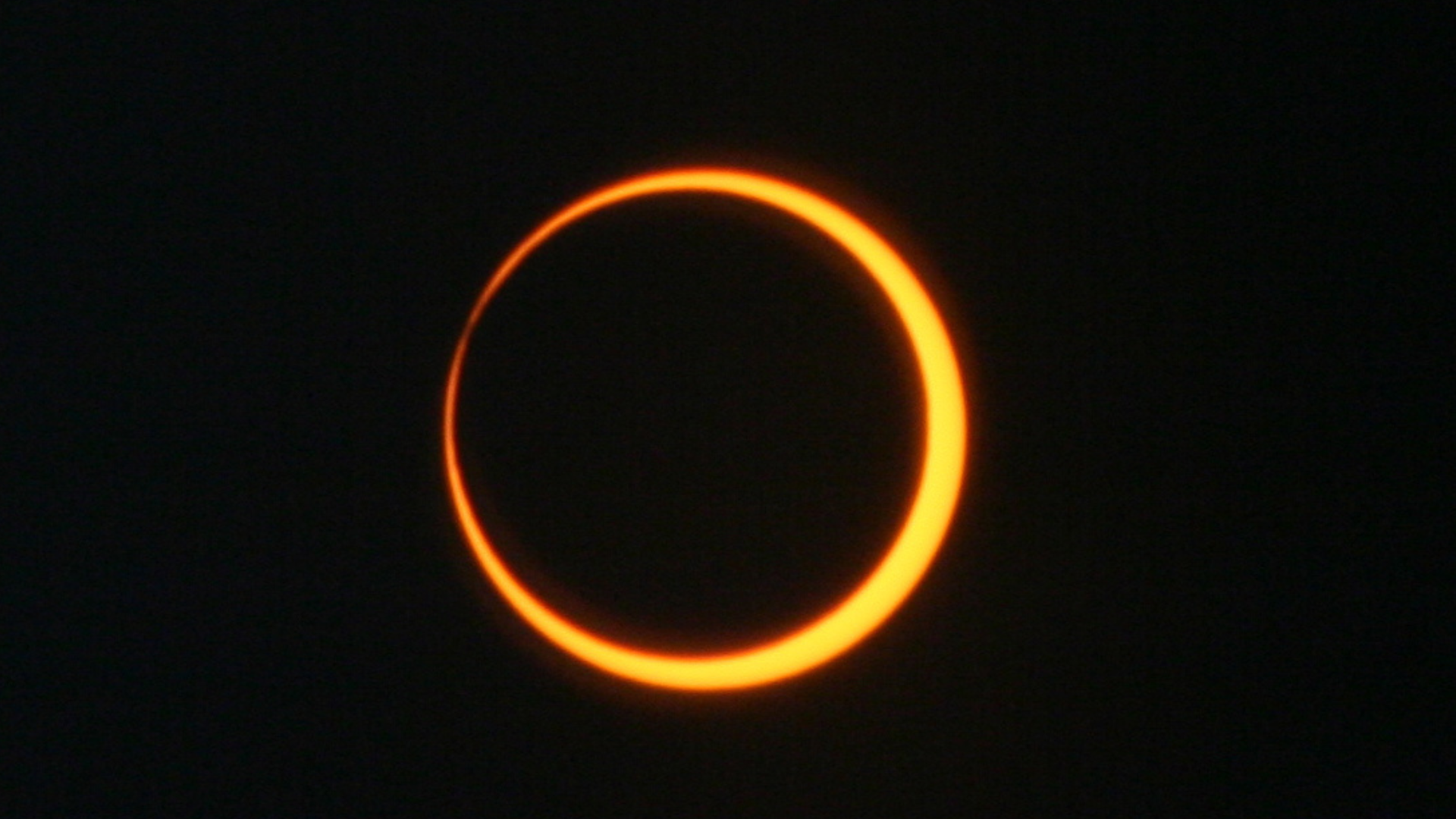'Ring of fire' solar eclipse on Oct. 14 forecast: Will the weather cooperate?

Almost all of North America will experience a weird and dramatic event on Saturday (Oct. 14), when a partial eclipse of the sun will be visible. Depending on where you are, the sun will appear slightly dented, deeply crescent shaped or even ring-shaped.
But skywatchers across the U.S. who are looking forward to viewing Saturday's solar eclipse may run into a problem thanks to several unsettled weather systems that will predominate over the east-central part of the country, as well as along the Pacific coast. You can watch the annular solar eclipse online here on Space.com courtesy of NASA, beginning at 11:30 a.m. EDT (1630 GMT), and follow along with all the action on our annular eclipse live updates page.
Along a path averaging 127 miles (204 kilometers) wide, running from the coast of Oregon southeast to the Gulf Coast of southern Texas, is where the main show — the sun appearing to morph into a spectacular "ring of fire" in the sky — will take place. Such a sight is referred to as an annular eclipse.
Unfortunately, along much of the annular eclipse path, clouds may hold the upper hand.
Related: What time is the annular solar eclipse on Oct. 14?
More: Which U.S. states will October's 'ring of fire' solar eclipse be visible from?
Clouds may eclipse the eclipse

If you're looking for safe optics to view the eclipse, we recommend the Celestron EclipSmart 2x Power Viewers, which have 2x magnification or this travel-friendly solar telescope. You can also consult our guide to photographing the solar eclipse.
On Saturday morning, a weakening cold front will straddle the Pacific coast from Oregon south to northern California. The front is expected to spread a swath of low cloudiness across Washington, Oregon and the western half of Idaho, as well as the northwest corner of Nevada and the northern third of California. Unfortunately, these clouds could hide the sun much of the time while the solar eclipse is taking place. Places within the eclipse path here include Eugene and Medford in Oregon and Alturas, California.
Farther down-track along the eclipse path, through the rest of Nevada, Utah, northeast Arizona and much of New Mexico, clouds are also expected to prevail, but they will likely be more of the mid-to-high level variety, not thick and opaque. Such clouds will probably be thin enough to allow for views of the sun through them, although they also could give a "milkiness" to the sky overall. Among locations within the path of the annular eclipse here are Winnemucca and Elko, Nevada; Richfield, Utah; and Albuquerque and Santa Fe, New Mexico.
Breaking space news, the latest updates on rocket launches, skywatching events and more!
A stalled weather front hung up over southern and southwestern Texas adjacent to the Mexican border might spoil the view by generating an area of cloud cover over places like Del Rio, Uvalde and perhaps San Antonio.
Perhaps the clearest views — with the fewest clouds — will be over southeast New Mexico, northwest Texas and the southern Gulf Coast of Texas. Places within this favored zone include Carlsbad and Hobbs, New Mexico and Midland, Odessa and Corpus Christi, Texas.
Farther east, a storm centered near the Indiana/Ohio border will spread a large area of clouds across the northern and central Plains, the Tennessee and Ohio river valleys, east to the Mid-Atlantic and Northeast. A second storm — the remnants of what was once Tropical Storm Lidia — will be moving off the coast of the Carolinas and will spread additional cloudiness over the Southeast U.S. Finally, a storm departing New England into Atlantic Canada will leave lingering cloud cover in its wake.
Refer to our U.S. map below for general probabilities for viewing the eclipse.
Of course, we stress that this national outlook is merely a generalization — a broad-brush look at sky conditions from coast to coast. For a more detailed and localized outlook, we suggest checking the latest updated forecast from your local National Weather Service office. Here is the link to the National Weather Service Organization page that lists all of the Weather Service Forecast Offices across the United States, including Alaska, Hawaii and the Pacific Region. Just click on the office that serves your area to get not only the latest weather outlook, but access to local radar and satellite imagery as well.
Related: How to observe the sun safely (and what to look for)
Circumstances of the eclipse
On Saturday, the moon will be nearly five days past apogee — that point in its orbit when it's farthest from Earth. As a consequence, the tip of the dark umbral shadow will fail to make contact with Earth by some 13,000 miles (21,000 kilometers). So, like a penny placed atop a nickel, the disk of the moon will appear too small to completely cover the sun.
To be precise, about 4.8% of the sun's width will show all around. The ring will shine with only one-tenth of the sun's normal total light, but this is less of a change than it sounds, since the eye adapts readily to changing light levels. The illumination will be no darker than on a bright overcast day. The quality of the light, however, may become unearthly. A clear sky should turn deep blue and the landscape oddly silvery. Venus, shining at magnitude minus 4.4, should become easily visible 46 degrees far to the right of the sun. Block the sun with your hand to search for it. (DO NOT look at the sun without eye protection during Saturday's eclipse; doing so could lead to permanent eye damage.)
An annular eclipse is not like totality. The sky gets no darker than in a deep partial eclipse; the sun's glorious corona, and the chromosphere and "edge effects" such as shadow bands, cannot appear. Yet "ring of fire" eclipses are still a spectacular sight, and enthusiasts will go to whatever section of the eclipse track is most easily accessible for them.
Virtually all of North and South America will be able to partake in viewing the associated partial eclipse; southerly locations will see a greater fraction of the sun's disk covered. In the eastern U.S. roughly 20 to 60% coverage takes place; for the central U.S., 60 to 80%; for the western U.S., 80% or more.
Joe Rao serves as an instructor and guest lecturer at New York's Hayden Planetarium. He writes about astronomy for Natural History magazine, the Farmers' Almanac and other publications.

Joe Rao is Space.com's skywatching columnist, as well as a veteran meteorologist and eclipse chaser who also serves as an instructor and guest lecturer at New York's Hayden Planetarium. He writes about astronomy for Natural History magazine, Sky & Telescope and other publications. Joe is an 8-time Emmy-nominated meteorologist who served the Putnam Valley region of New York for over 21 years. You can find him on Twitter and YouTube tracking lunar and solar eclipses, meteor showers and more. To find out Joe's latest project, visit him on Twitter.

